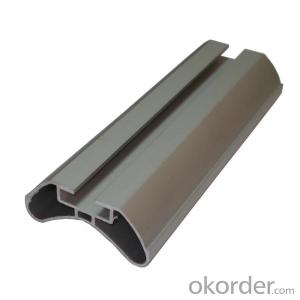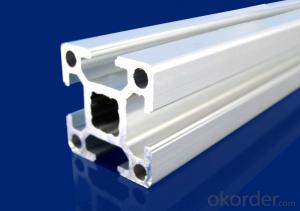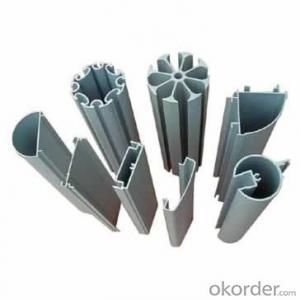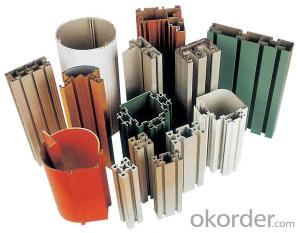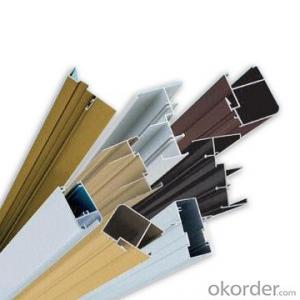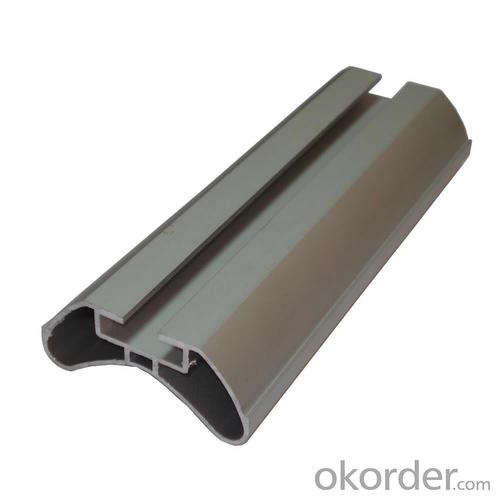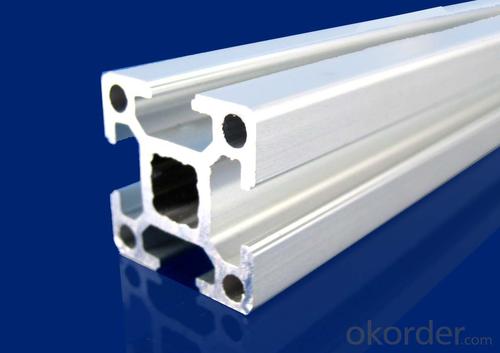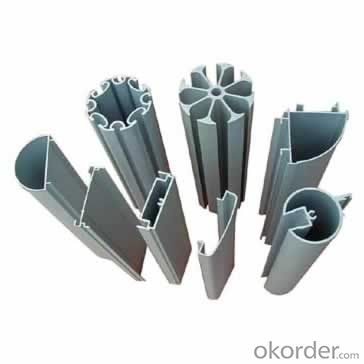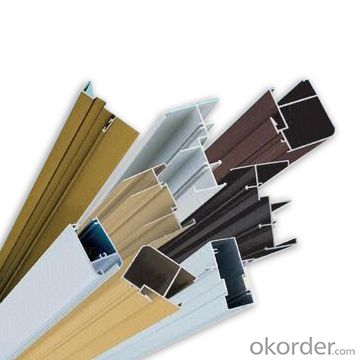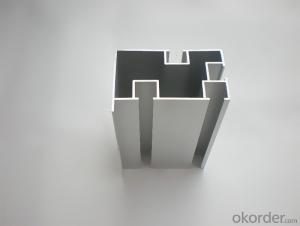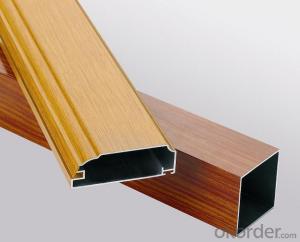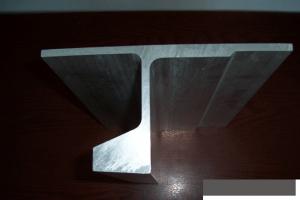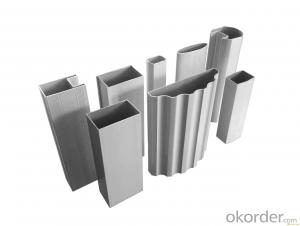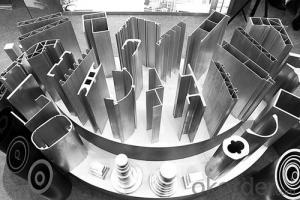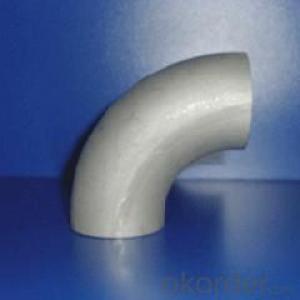Aluminum Strut Profiles 6061 Aluminum Profile Extrusion
- Loading Port:
- China Main Port
- Payment Terms:
- TT OR LC
- Min Order Qty:
- -
- Supply Capability:
- -
OKorder Service Pledge
OKorder Financial Service
You Might Also Like
Aluminium is a relatively soft, durable, lightweight, ductileand malleablemetalwith appearance ranging from silvery to dull gray, depending on the surfaceroughness. It is nonmagnetic and does not easily ignite. A fresh film ofaluminium serves as a good reflector (approximately 92%) of visible lightand an excellent reflector (as much as 98%) of medium and far infraredradiation. The yield strength of pure aluminium is 7–11 MPa,while aluminium alloys have yield strengths ranging from200 MPa to 600 MPa. Aluminium has about one-third the densityand stiffness of steel. It is easily machined,cast, drawn and extruded.
Aluminium alloys (or aluminum alloys; see spellingdifferences) are alloysin which aluminium(Al) is the predominant metal. The typical alloying elements are copper, magnesium,manganese,silicon,tin and zinc. There are twoprincipal classifications, namely casting alloys and wrought alloys, both of which are furthersubdivided into the categories heat-treatableand non-heat-treatable. About 85% of aluminium is used for wrought products,for example rolled plate, foils and extrusions.Cast aluminium alloys yield cost-effective products due to the low meltingpoint, although they generally have lower tensile strengthsthan wrought alloys. The most important cast aluminium alloy system is Al–Si,where the high levels of silicon (4.0–13%) contribute to give good castingcharacteristics. Aluminium alloys are widely used in engineering structures andcomponents where light weight or corrosion resistance is required
Features:
Material | Alloy 6063,6061,6005or according to customer’s choice |
Temper | T3, T4, T5, T6 |
Surface | Anodize, electrophoresis, powder coating, PVDF coating, wood grain painting, matted, etc. |
Length | Coating 6.5 meters, Anodizing 6.5 meters, Mill finish 5 meters |
Application | Industrial, electrical equipment(TV set, air conditioner, refrigerator, computer), decoration,construction, transportation |
Custom Made | We can package following with customer's request. |

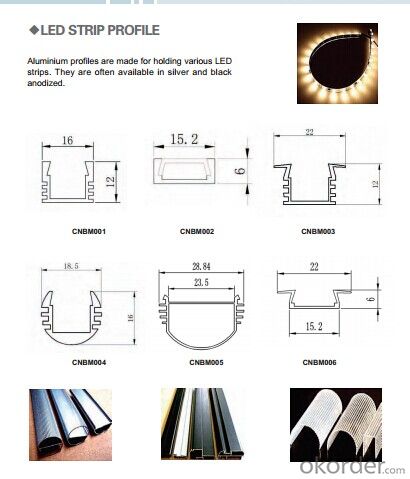
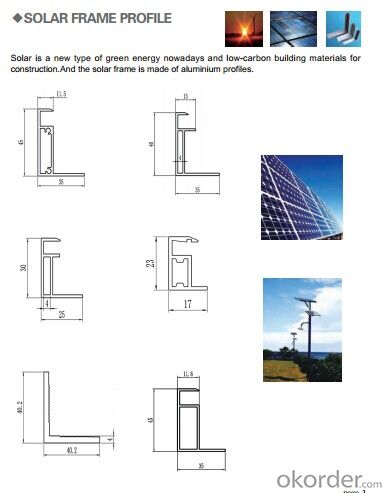
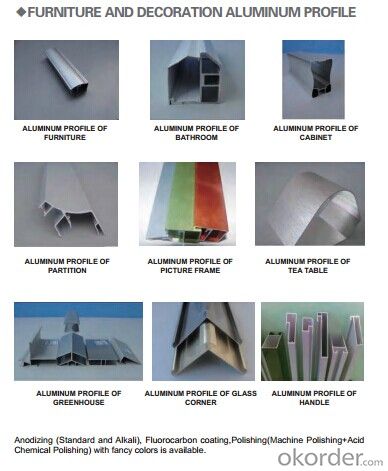
FAQ:
1. What is the form of payment?
Normally 30% TT, L/C at sight
2. Type of quotation?
FOB, CFR, CIF
3. Port of loading?
Shenzhen/Guangzhou port
4. Delivery time?
15-20 days after client’s deposit
- Q: How much does aluminum mold need?
- The cost of aluminum profile die is judged according to the size of the profile. The length of the profile diagonal and the length of the profile to be produced have direct influence on the die cost. For example, an outer diameter 60mm diameter 40mm of the aluminum tube, in general circumstances, open a diameter of 178mm, thickness of 120mm mold can be produced. But if you request that the length of the aluminum tube produced is 5 meters or longer, this should be a mold with a diameter of 220mm and a thickness of 138mm, so as to squeeze on a larger machine with a larger bar. Of course, this is only one, for example, specific questions should be analyzed in detail.
- Q: How do aluminum profiles perform in terms of energy efficiency?
- Aluminum profiles are known for their excellent energy efficiency properties. They are widely used in various industries and applications, including construction, transportation, and manufacturing, due to their ability to contribute to energy savings and sustainability. One of the main reasons for their energy efficiency is the lightweight nature of aluminum. Compared to other materials like steel, aluminum profiles are significantly lighter, which means less energy is required for transportation and installation. This reduces the overall carbon footprint associated with the manufacturing and use of aluminum profiles. Additionally, aluminum has a high thermal conductivity, which allows for efficient heat transfer. This property is particularly beneficial in windows and doors applications. Aluminum profiles can effectively regulate the transfer of heat between the interior and exterior of a building, thereby reducing the need for excessive heating or cooling. This results in energy savings and reduced energy consumption. Furthermore, aluminum profiles can be easily integrated with additional energy-efficient components, such as thermal breaks and insulating materials. These additions further enhance the energy performance of aluminum profiles by minimizing thermal bridging and improving insulation, thus reducing energy loss. Moreover, aluminum is a highly durable and long-lasting material, which means that structures and products made with aluminum profiles require less maintenance and replacement over time. This durability contributes to overall energy efficiency by reducing the energy and resources needed for repairs and replacements. In conclusion, aluminum profiles are highly regarded for their energy efficiency characteristics. They are lightweight, have excellent thermal conductivity, can be integrated with energy-efficient components, and offer long-term durability. These qualities make aluminum profiles a sustainable choice that can contribute to energy savings and reduced environmental impact in various applications.
- Q: Are aluminum profiles painted by powder or by fluorocarbon spray? How can they be distinguished from appearance?
- The surface treatment of the curtain wall aluminum plate is solved by electrostatic spraying, not only the color difference becomes smaller, but also the aluminum plate with various colors can be obtained. Electrostatic spraying can be divided into powder spraying and fluorocarbon spraying. The raw materials of powder spraying are polyurethane, polyurethane resin, epoxy resin, hydroxyl polyester resin and epoxy / polyester resin, which can be made into many colors. The characteristics of powder spraying: spraying equipment manual, automatic hanging type, simple construction, the thickness of the coating is 30 micron, impact resistance, abrasion resistance, corrosion resistance, weather resistance are good, the price cheaper than fluorocarbon coatings.
- Q: Aluminum profile 606360056061, T5 and T6 hardness GB, how much?
- Generally divided into Vivtorinox hardness, Rockwell hardness and Vickers hardness and webster hardness. Our enterprises are generally in accordance with webster hardness test, GB 6063-T5 8HW 6063-T6 11.5HW6005-T5 15HW 6005-T6 15HW6061-T5 15HW 6061-T6 15HWIf you need other hardness units, you can refer to the conversion
- Q: Differences between industrial aluminum and iron products
- The so-called aluminum steel, generally divided into sections and plates, pipes and metal products in these four categories, general structural steel is usually refers to the production of metal structure steel for buildings, bridges, ships, boiler or other engineering. Such as carbon structural steel, low alloy steel, steel and so on.
- Q: Are aluminum profiles suitable for decorative applications?
- Indeed, decorative applications can benefit greatly from the use of aluminum profiles. This material, known for its versatility, provides numerous advantages in decorative contexts. To start with, aluminum profiles can be easily shaped and molded into various designs, offering endless possibilities for decorative applications. Designers have the freedom to extrude them into different shapes, sizes, and patterns, allowing for the creation of unique and visually pleasing decorative elements. Furthermore, aluminum profiles exhibit excellent durability and resistance to corrosion, making them suitable for both indoor and outdoor decorative applications. Thanks to their rust and weather resistance, decorative elements made from aluminum profiles can maintain their appearance for an extended period. Moreover, aluminum profiles can be finished in different ways to enhance their decorative appeal. Anodizing or powder-coating can be applied to the surface, adding color, texture, and protection. These finishing options allow for customization and the ability to harmonize the profiles with the overall design scheme. Additionally, aluminum profiles possess the advantageous combination of being lightweight and strong, facilitating their installation and handling during the decorative application process. This characteristic is especially valuable in situations where weight is a consideration, such as with suspended or wall-mounted decorative elements. Finally, it is worth noting that aluminum is an environmentally friendly and sustainable material. It is entirely recyclable, and the production process of aluminum profiles requires significantly less energy compared to other materials. By choosing aluminum profiles for decorative applications, one aligns with sustainable design principles and contributes to reducing the environmental impact. In conclusion, the versatility, durability, corrosion resistance, customization options, lightweight nature, and sustainability of aluminum profiles make them highly suitable for decorative applications. Whether it is for interior or exterior decorative elements, aluminum profiles offer a wide range of possibilities to enhance the aesthetic appeal of any space.
- Q: What are the different cutting methods for aluminum profiles?
- Depending on the specific requirements and desired outcome, there are various cutting methods available for aluminum profiles. Some of the most commonly used cutting methods for aluminum profiles are as follows: 1. Saw cutting: By using a saw blade, the aluminum profile can be cut. This method is versatile and widely employed, offering high precision and producing straight cuts. Saw cutting is suitable for both small and large-scale production. 2. Shearing: This method involves the use of a guillotine-like tool to cut through the aluminum profile. Shearing is a quick and efficient method for cutting straight lines in aluminum profiles of different thicknesses. However, it may not be suitable for cutting complex shapes or angles. 3. CNC machining: Computer numerical control (CNC) machining is a highly precise cutting method that utilizes computer-controlled machines to cut aluminum profiles. It provides a wide range of cutting options, including complex shapes, angles, and contours. CNC machining is ideal for custom or intricate designs, but it may be more time-consuming and costly compared to other methods. 4. Laser cutting: Laser cutting utilizes a high-powered laser beam to cut through the aluminum profile. It is a precise and efficient method that can produce intricate and detailed cuts with minimal heat distortion. Laser cutting is highly suitable for thin aluminum profiles and is commonly used in industries such as aerospace and automotive. 5. Waterjet cutting: Waterjet cutting involves the use of a high-pressure stream of water mixed with an abrasive material to cut through the aluminum profile. It is a versatile method that can cut through various thicknesses and materials, including aluminum. Waterjet cutting is ideal for cutting complex shapes and has minimal heat-affected zones. 6. Plasma cutting: Plasma cutting utilizes a plasma torch to cut through the aluminum profile. It is a fast and efficient method that can handle thicker aluminum profiles. However, the heat generated during plasma cutting can cause distortion and may require additional post-cutting processes. In conclusion, the selection of a cutting method for aluminum profiles depends on factors such as desired cut quality, complexity of the design, production volume, and budget. Considering these factors is essential in choosing the most suitable cutting method for a specific application.
- Q: Can aluminum profiles be recycled indefinitely?
- No, aluminum profiles cannot be recycled indefinitely. While aluminum is highly recyclable and can be recycled multiple times, the quality of the material gradually degrades with each recycling process. Eventually, the aluminum profiles will become unsuitable for further recycling and need to be disposed of.
- Q: How do aluminum profiles perform in terms of sound transmission loss?
- Aluminum profiles are known for their excellent sound transmission loss performance. Due to their dense and rigid nature, aluminum profiles effectively block and reduce the transmission of sound waves. The metal's inherent properties, such as high density and low resonance, make it an ideal material for sound insulation applications. Additionally, aluminum profiles can be designed with various shapes and thicknesses to further enhance their soundproofing capabilities. Overall, aluminum profiles offer great sound transmission loss, making them a popular choice for applications where noise reduction is desired, such as in building construction, automotive industry, and HVAC systems.
- Q: Are aluminum profiles suitable for use in mining and construction equipment?
- Yes, aluminum profiles are suitable for use in mining and construction equipment. Aluminum offers a unique set of properties that make it highly suitable for these industries. Firstly, aluminum is lightweight, which helps in reducing the overall weight of the equipment, making it easier to transport and maneuver on construction sites or in mining operations. This lightweight nature also allows for increased fuel efficiency, reducing operational costs. Additionally, aluminum profiles have excellent corrosion resistance, which is crucial in these industries where equipment may be exposed to harsh weather conditions or corrosive substances. This resistance to corrosion ensures that the equipment remains durable and long-lasting, even in challenging environments. Furthermore, aluminum profiles can be easily fabricated and customized to suit specific requirements. This flexibility in design allows for the creation of complex shapes and structures, enabling the construction of equipment with optimal strength and functionality. Moreover, aluminum profiles have high thermal conductivity, which effectively dissipates heat generated during mining and construction operations. This property is essential in preventing overheating or damage to the equipment and ensures efficient performance even in intense working conditions. Overall, the combination of lightweight, corrosion resistance, versatility, and thermal conductivity makes aluminum profiles a suitable choice for use in mining and construction equipment.
Send your message to us
Aluminum Strut Profiles 6061 Aluminum Profile Extrusion
- Loading Port:
- China Main Port
- Payment Terms:
- TT OR LC
- Min Order Qty:
- -
- Supply Capability:
- -
OKorder Service Pledge
OKorder Financial Service
Similar products
Hot products
Hot Searches
Related keywords
